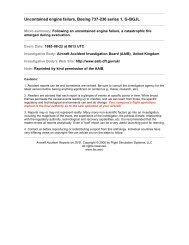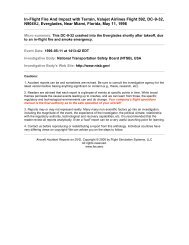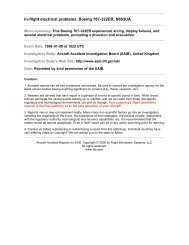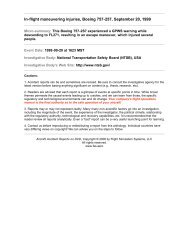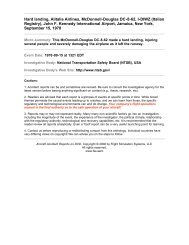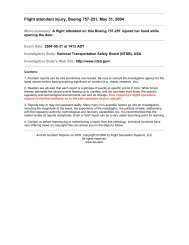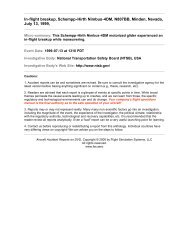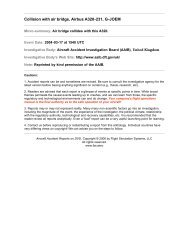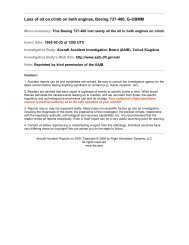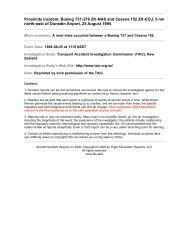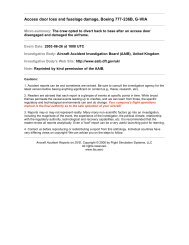Executive Summary - Fss.aero
Executive Summary - Fss.aero
Executive Summary - Fss.aero
Create successful ePaper yourself
Turn your PDF publications into a flip-book with our unique Google optimized e-Paper software.
standby. At 0818, the tower informed airline service crew of the same news. Because<br />
the<br />
Taipei Area Control Center delivered the wrong information to the tower as and in<br />
turn, to the aviation service crew, OK area control center misunderstood the request of<br />
the co-pilot.<br />
It was until 0825 that China Airlines (Asian Dispatch<br />
Center) informed the CKS<br />
Airport<br />
aviation services crew it has been confirmed that it was the pilot who lost<br />
consciousness. It was only at that point in time that the CKS aviation service crew and<br />
the airport central control center notified the units to start firefighting and search and<br />
rescue<br />
proceedings. The incapacitation of the pilot and the aircraft having to return to<br />
base poses a very big potential threat. With the transmission of faulty information,<br />
then later to be modified, time needed to prepare and adapt to the situation was<br />
severely reduced.<br />
2.4.2<br />
Announcement of emergency situation<br />
At 0816, the co-pilot found out that the chief pilot was incapacitated and used the<br />
word “Incapacity” in informing airport management personnel. At 0831, because<br />
there were other aircrafts, which<br />
have requested “Priority,” nobody knew that the<br />
aircraft<br />
had an emergency situation until it landed. Based on Chapter 9 Section 9-1-1<br />
of the Aviation Control Procedures, the decision for emergency situations are as<br />
follows:<br />
Emergency situations may be perilous or urgent in nature, the definition of which is<br />
included in the pilot/ control personnel dictionary. (Emergency situation may refer to<br />
perilous or urgent)<br />
b. When a pilot encounters<br />
a perilous situation, he/she should use the word<br />
“MAYDAY” in the initial radio communication<br />
to signify that there is an emergency<br />
situation, ideally repeating it three times. When the situation is urgent, the word to use<br />
is “PAN-PAN,” again following the same process.<br />
c. If neither “MAYDAY” nor “PAN-PAN” is used, but the control personnel suspects<br />
that this situation may turn into something urgent or perilous, he may act accordingly.<br />
The Flight Safety Foundation published the Airport Operation Magazine Vol. 26, No.3<br />
in March-April 2000. Said magazine offers some standard language that aviation<br />
personnel<br />
can use when announcing any emergency situation. (See Appendix 19)<br />
Chapter 14 of China Airlines’ aviation handbook states that radio communication<br />
46



